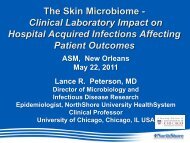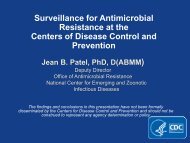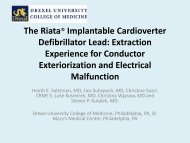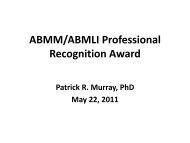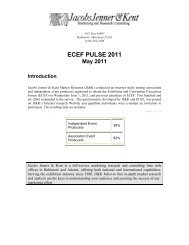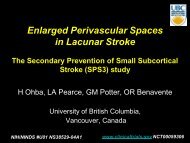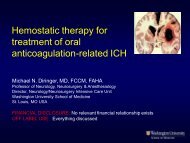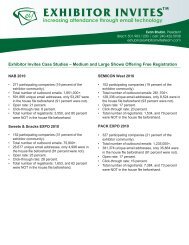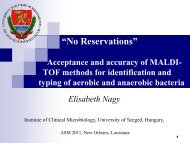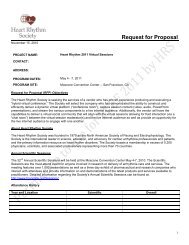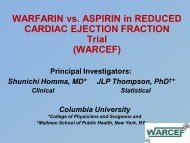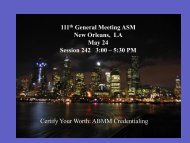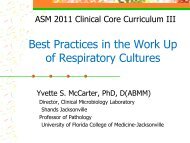Molecular vs non-Molecular Testing for MRSA/MSSA: The Case for ...
Molecular vs non-Molecular Testing for MRSA/MSSA: The Case for ...
Molecular vs non-Molecular Testing for MRSA/MSSA: The Case for ...
You also want an ePaper? Increase the reach of your titles
YUMPU automatically turns print PDFs into web optimized ePapers that Google loves.
<strong>Molecular</strong> <strong>vs</strong> <strong>non</strong>-<strong>Molecular</strong><br />
<strong>Testing</strong> <strong>for</strong> <strong>MRSA</strong>/<strong>MSSA</strong>:<br />
<strong>The</strong> <strong>Case</strong> <strong>for</strong> <strong>Molecular</strong><br />
Lance R. Peterson, MD<br />
Director of Microbiology and<br />
Infectious Disease Research<br />
Epidemiologist, NorthShore University<br />
HealthSystem<br />
Clinical Professor<br />
University of Chicago, Chicago, IL USA
• Research Grants<br />
Potential COI<br />
– Bayer, Cepheid, NorthShore, GeneOhm, GSK, Johnson<br />
and Johnson, Merck, MicroPhage, Nanogen,<br />
Nanosphere, NIAID, Roche, 3M, Washington Square<br />
Health Foundation, Wyeth (Pfizer), AHRQ<br />
• Consultations (in conjunction with research<br />
projects and new diagnostics)<br />
– Cepheid, GeneOhm, GSK, MicroPhage, Nanogen,<br />
Nanosphere, Roche, 3M, Wyeth (Pfizer)<br />
• Industry support <strong>for</strong> this presentation<br />
– None
Goals of the Presentation<br />
• To present the case <strong>for</strong> molecular testing<br />
when per<strong>for</strong>ming surveillance <strong>for</strong> <strong>MRSA</strong> and<br />
<strong>MSSA</strong><br />
– <strong>MRSA</strong> control programs<br />
– Pre-surgical testing to lower surgical site<br />
infections<br />
• Will not discuss clinical disease diagnostics<br />
from direct specimens or detection of<br />
staphylococci from blood culture bottles
US Infection Mortality 2005<br />
FR DeLeo &<br />
HF Chambers<br />
JCI 119:2464, 2009
<strong>MRSA</strong> Risk Following Colonization<br />
• 43,504 patients had surveillance <strong>for</strong> <strong>MRSA</strong><br />
• 7.4% of asymptomatic <strong>MRSA</strong> carriers developed<br />
<strong>MRSA</strong> infection over 1 year<br />
• 0.5% of <strong>MRSA</strong> nasal negative patients developed<br />
infection over 1 year<br />
• Over 10-fold higher risk of disease with <strong>MRSA</strong><br />
colonization<br />
– Highest risk <strong>for</strong> <strong>MRSA</strong> infection is nasal carriage<br />
(p
Do Colonized Patients Spread <strong>MRSA</strong>?<br />
• Compared 58 patients with <strong>MRSA</strong> disease to<br />
57 with nasal colonization to determine risk <strong>for</strong><br />
skin and environmental contamination<br />
– Skin and environment contaminated 50 <strong>vs</strong> 47%<br />
– Various skin sites 38-66% <strong>vs</strong> 30-63%<br />
– Various environment sites 27-60% <strong>vs</strong> 21-63%<br />
• Glove acquisition from skin 14-45% <strong>vs</strong> 16-38%<br />
• “Strategies to limit transmission must address<br />
colonized patients”<br />
S Chang et al, CID 48: 1423-8, 2009
Risk <strong>for</strong> S. aureus Infection<br />
• Systematic review (10 studies) to estimate of<br />
the risk of infection following colonization with<br />
<strong>MRSA</strong> compared with colonization by <strong>MSSA</strong><br />
• Random effects model was used to obtain<br />
pooled odds ratio estimates<br />
• Overall, colonization by <strong>MRSA</strong> was<br />
associated with a 4-fold increase in the risk of<br />
infection (odds ratio 4.08, 95% confidence<br />
interval = 2.10-7.44) N Safdar et al. Am J Med 121:310-15, 2008
Critical Review of <strong>MRSA</strong><br />
Screening by Rapid Methods<br />
• Review and meta-analysis of randomized, <strong>non</strong>randomized,<br />
and observational studies<br />
– Random-effects model was used<br />
– Ten studies (nine interventional studies and one<br />
unblinded, cluster-randomized, crossover trial) reviewed<br />
• Between wards applying rapid screening tests and<br />
those without screening, noted a significantly<br />
decreased risk <strong>for</strong> <strong>MRSA</strong> bloodstream infections<br />
• Overall, concluded that active screening <strong>for</strong> <strong>MRSA</strong><br />
is more important than the type of test used<br />
E Tacconelli et al. Lancet Infect Dis 9: 546–54, 2009
Critical Review of <strong>MRSA</strong><br />
Screening by Rapid Methods:<br />
Surveillance <strong>vs</strong> no Surveillance<br />
E Tacconelli et al. Lancet Infect Dis 9: 546–54, 2009
Critical Review of <strong>MRSA</strong><br />
Screening by Rapid Methods:<br />
Surveillance <strong>vs</strong> no Surveillance<br />
E Tacconelli et al. Lancet Infect Dis 9: 546–54, 2009
Influence of Test Impact on Cost<br />
Impact of a <strong>MRSA</strong> Program<br />
• Excel-based decision-analytic model to<br />
compare hospital costs and <strong>MRSA</strong> infection<br />
rates <strong>for</strong> PCR or culture-based screening<br />
• Simulated 370-bed hospital in the US<br />
• Screening different populations gave savings<br />
of $12,158–$76,624/month over no program<br />
• Same-day PCR testing resulted in fewer<br />
infections and the lowest total cost<br />
N Olchanski et al. ICHE 32:250-7, 2011
How Can We Explain the<br />
Variation in Results?
Per<strong>for</strong>mance of rtPCR and Culture<br />
• 250 rtPCR positive and 250 rtPCR negative<br />
samples tested by BD GeneOhm and two<br />
Chromogenic media (direct and enriched)<br />
• True Positive = culture positive or <strong>MRSA</strong><br />
history (n = 186)<br />
CHROMagar<br />
<strong>MRSA</strong> (Direct)<br />
<strong>MRSA</strong>Select<br />
(Direct)<br />
CHROMagar<br />
<strong>MRSA</strong><br />
(Enriched)<br />
<strong>MRSA</strong>Select<br />
(Enriched)<br />
Sensitivity 80.6% 78.5% 86.6% 90.3%<br />
Specificity 100% 97.4% 99.7% 91.6%<br />
• Past per<strong>for</strong>mance showed rtPCR to be 98.2%<br />
sensitive and 97.5% specific<br />
SM Paule et al, AJCP 131:532-9, 2009<br />
SM Paule et al, JCM 45:2993-8, 2007
Test Comparison<br />
• Examined impact of turnaround time,<br />
sensitivity, specificity and <strong>MRSA</strong> prevalence<br />
on the characteristics of a surveillance<br />
program<br />
• Studied 37,179 consecutive <strong>MRSA</strong>-tested<br />
admissions to NorthShore (one year)<br />
Ari Robicsek, ICAAC/IDSA 2008<br />
SM Paule et al, Am J Clin Pathol 131:532-9, 2009
% of isolation days missed<br />
50<br />
45<br />
40<br />
35<br />
30<br />
25<br />
20<br />
15<br />
10<br />
5<br />
0<br />
Missed Isolation Day Percentage: Method Comparison<br />
Traditional or Chrom. Agar<br />
Enrichment + Chrom. Agar<br />
rtPCR<br />
0 3 6 9 12 15 18 21 24 27 30 33 36 39 42 45 48 51 54 57 60 63 66 69 72 75 78 81 84<br />
Turnaround Time (hours)<br />
Ari Robicsek, ICAAC/IDSA 2008
Predictors of Program Success<br />
Author<br />
Disease<br />
reduced with<br />
<strong>MRSA</strong> Mean Length of<br />
Prevalence pre-emptive Hospital Stay<br />
isolation<br />
Test<br />
Sensitivity<br />
Time to<br />
Result<br />
Reporting<br />
Length of<br />
Intervention<br />
Period<br />
Estimated<br />
<strong>MRSA</strong> Days<br />
Captured<br />
Program was<br />
Successful<br />
Harbarth et al 6.7% 3.7 to 4 days 84% ≥22.2 hours 5 to 17 months 63% No reduction in<br />
disease<br />
Harbarth et al 5.1% 6.4 days 84% ≥22 to23 hours 9 months 72% No reduction in<br />
disease<br />
Robicsek et al 6.3% 4.6 days 98% 15 hours 21 months 85% Reduction in<br />
disease with<br />
universal<br />
surveillance<br />
Jeyaratnam et al 6.7% 3.8 days 87.8% ≥22 hours 5 months 67% No reduction in<br />
transmission or<br />
disease<br />
Hardy et al 6.3% 7.2 days 98% 22 hours 8 months 86% Reduction in<br />
transmission<br />
Hardy et al 5.2% 6.5 days ≤73% 42 hours 8 months 53% No reduction in<br />
(direct culture)<br />
transmission<br />
Bowler et al 14.6% > 1 year 80% 48 hours 2 years 80% Reduction in<br />
disease<br />
L Peterson, JCM, 48:683-9, 2010
% of isolation days missed<br />
50<br />
45<br />
40<br />
35<br />
30<br />
25<br />
20<br />
15<br />
10<br />
5<br />
0<br />
Missed Isolation Day Percentage: Method Comparison<br />
† = Failed Programs<br />
* = Successful Program<br />
†<br />
Program † likely successful if capture<br />
>80% of <strong>MRSA</strong> potential isolation days<br />
*<br />
*<br />
0 3 6 9 12 15 18 21 24 27 30 33 36 39 42 45 48 51 54 57 60 63 66 69 72 75 78 81 84<br />
Turnaround Time (hours)<br />
Traditional or Chrom Agar<br />
Enrichment + Chrom Agar<br />
rtPCR<br />
Ari Robicsek, ICAAC/IDSA 2008; A Robicsek et al, An Int Med, 48:409-18, 2008; D Jeyaratnam et al, BMJ ,<br />
336;927-30, 2008; S Harbarth et al, Crit Care 10:R25, 2006; Ari Robicsek, ICAAC/IDSA 2008; K Hardy et al,<br />
Clin Microbiol Infect 10.1111/j.1469-0691.2009; WA Bowler et al. ICHE 31:269-75, 2010; WC Huskins et al.<br />
NEJM 364:1407-18, 2011<br />
†<br />
*<br />
†<br />
†
Effectiveness of Various Strategies<br />
Hospital-associated <strong>MRSA</strong> BSI incidence in December 2004:<br />
Declined from a projected 4.6/1,000 to 1.5/1,000 patients<br />
<strong>MRSA</strong> colonized patient LOS = 35 days<br />
SS Huang et al, CID 43:971-8, 2006
Veterans Administration<br />
Healthcare System (153 Hospitals)<br />
• Reported 21-month results of all admission<br />
screening <strong>for</strong> <strong>MRSA</strong> based on 1,312,840<br />
admissions covering 8,318,675 patient days<br />
• 45% reduction in <strong>MRSA</strong> disease in <strong>non</strong>-ICU<br />
patients (P = 0.001) throughout the system<br />
• 62% reduction in <strong>MRSA</strong> disease <strong>for</strong> ICU<br />
patients (P < 0.001)<br />
– 2 year baseline in ICU patients had no change in<br />
disease<br />
R Jain et al. NEJM 364:1419-30, 2011<br />
• <strong>Testing</strong> primarily (92%) with rtPCR methods
Cluster Randomized Trial of ICU:<br />
Demonstrated <strong>non</strong>-Utility of Culture<br />
• Assessed VRE and <strong>MRSA</strong> surveillance plus<br />
enhanced barrier precautions in the ICU<br />
• 5,434 admissions to 10 intervention ICUs, and 3,705<br />
to 8 control ICUs over 6 months<br />
– Centralized, broth enriched culture used <strong>for</strong> testing<br />
• Incidence of colonization or infection with <strong>MRSA</strong> or<br />
VRE per 1000 patient-days at risk did not differ<br />
significantly (P = 0.35)<br />
• Mean (±SD) number of days from when surveillance<br />
swab obtained until it was reported was 5.2±1.4<br />
– 41% of patient days captured after reporting<br />
WC Huskins et al. NEJM 364:1407-18, 2011
What About Surgical Site<br />
Infections?
Changing Prevalence of<br />
S. aureus in Surgery<br />
• Percentage of S. aureus as a cause of<br />
Surgical Site Infection in Coronary Artery<br />
Bypass Grafting, Cholecystectomy,<br />
Colectomy and Total Hip Arthroplasty rose<br />
from 17% to 31% between 1992-2002<br />
JA Jernigan, Maryland Patient Safety Center (NNIS), January 12, 2006
NorthShore Program <strong>for</strong> Detection of<br />
Staphylococcus aureus Colonization:<br />
Process Overview<br />
• <strong>The</strong> patient is screened <strong>for</strong> S. aureus in the<br />
nose 0-28 days prior to surgery<br />
• If the test is positive, the physician will then<br />
prescribe a 5-day course of mupirocin ointment<br />
• <strong>The</strong> patient administers the nasal ointment<br />
twice a day <strong>for</strong> the 5 days in the month prior to<br />
surgery DM Hacek et al. Clin Orthop Relat Res 466:1349-55, 2008
Results of Preoperative Screening<br />
<strong>for</strong> NorthShore Hip and Knee Surgery<br />
Patients (n = 1,495)<br />
• S. aureus SSI rate of decolonized S. aureus<br />
carriers reduced 3.8-fold (p≤0.05)<br />
• Overall S. aureus infection rate in screened<br />
versus unscreened group was 0.8% versus<br />
1.7% DM Hacek et al Clin Orthop Relat Res 466:1349-55, 2008
Prospective, Randomized Trial of<br />
S. aureus decolonization<br />
• Multicenter, prospective placebo controlled trial of<br />
6,771 patients between 2005 and 2007<br />
– Intervention was rtPCR screening with nasal<br />
mupirocin/chlorhexidine bath <strong>for</strong> positive patients<br />
• 808 positive patients had surgery<br />
– 4 deep infections (0.9%) occurred in the treated group<br />
– 16 infections (4.4%) occurred in the placebo group<br />
» RR 0.21; 95% CI = 0.07-0.62<br />
– LOS 1.8 days shorter in the treated group (p=0.04)<br />
– Time to infection was shorter in the placebo group<br />
(p=0.005) LGM Bode et al. NEJM 362: 9-17, 2010
What is the Role of PCR?
Per<strong>for</strong>mance of rtPCR and Culture<br />
• Tested 5,838 paired nasal swabs to compare<br />
Roche rtPCR <strong>MRSA</strong> assay and Chromogenic<br />
<strong>MRSA</strong> agar (direct and broth enriched)<br />
• True Positive = culture positive or <strong>MRSA</strong><br />
history (n = 397)<br />
CHROMagar<br />
<strong>MRSA</strong><br />
(Direct)<br />
CHROMagar<br />
<strong>MRSA</strong><br />
(Enriched)<br />
rtPCR<br />
Sensitivity 57.7% 67% 98.3% (96.3% to 99.2%)<br />
Specificity 99.7% (98.6% to 99.1%)<br />
P Patel et al, IDSA 2011
Summary<br />
• <strong>MRSA</strong> surveillance in acute care settings at<br />
modest prevalence likely requires a rapid<br />
molecular test <strong>for</strong> success<br />
• In long term care or where <strong>MRSA</strong> prevalence<br />
is high, culture may be satisfactory<br />
• For surgery patients, the higher sensitivity of<br />
rtPCR likely makes this the preferred testing<br />
approach



